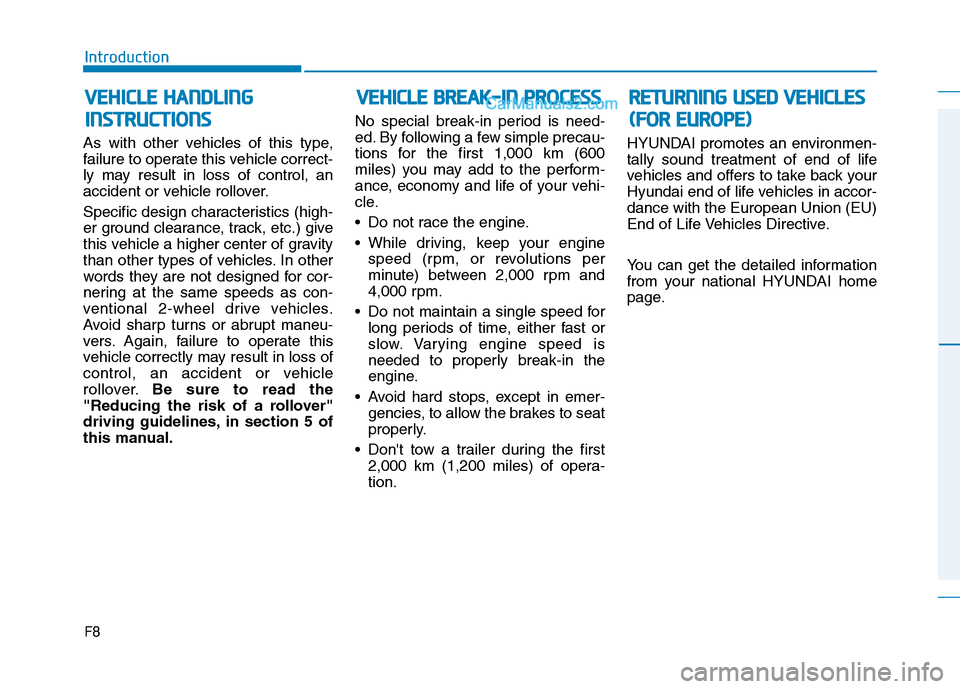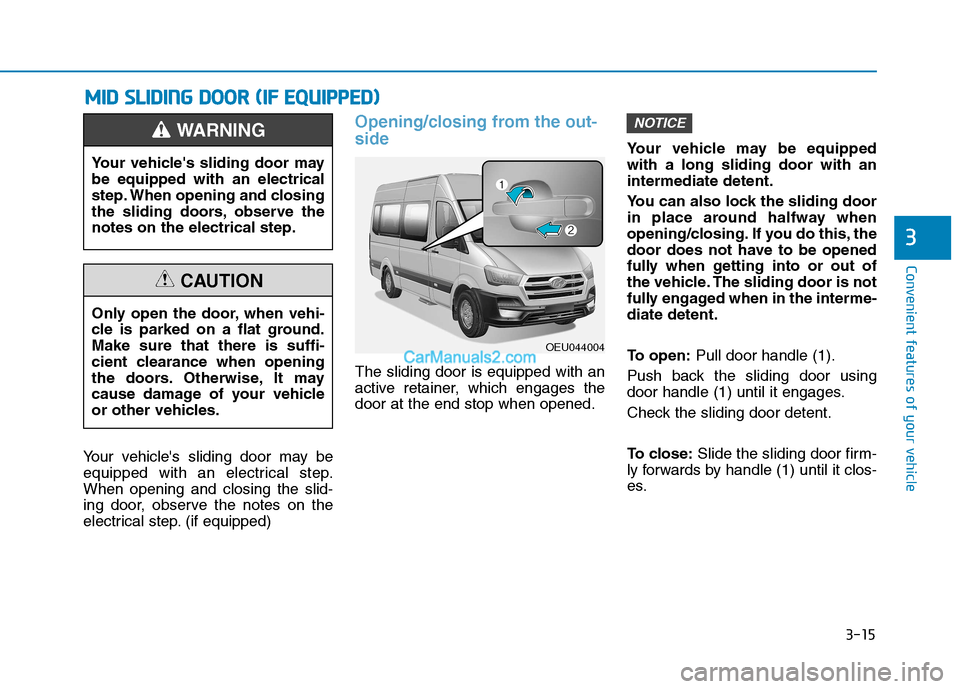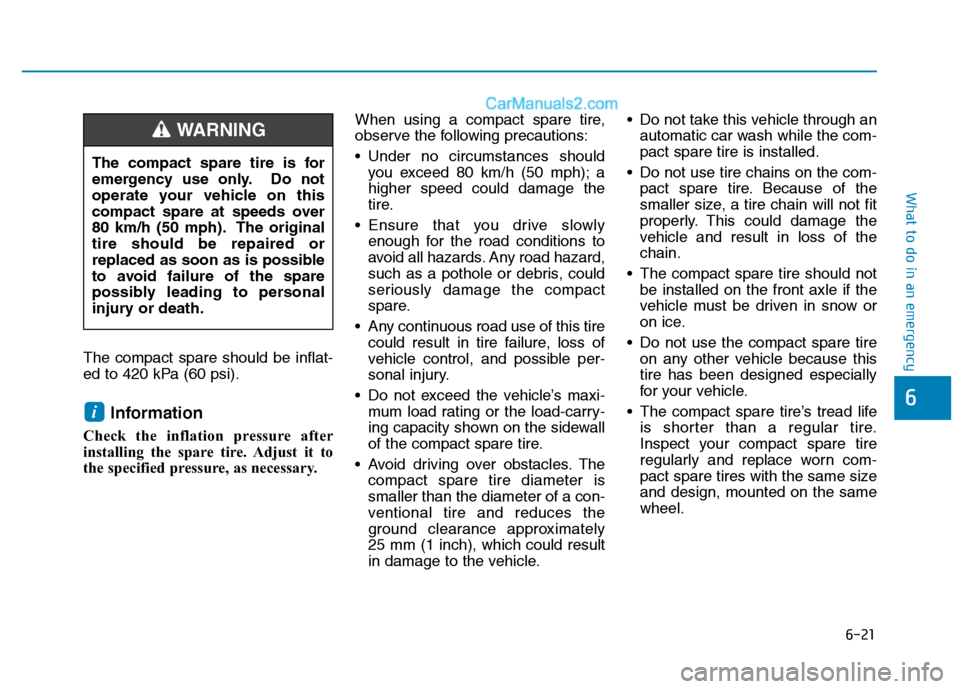2016 Hyundai H350 ground clearance
[x] Cancel search: ground clearancePage 8 of 473

F8
Introduction
As with other vehicles of this type,
failure to operate this vehicle correct-
ly may result in loss of control, an
accident or vehicle rollover.
Specific design characteristics (high-
er ground clearance, track, etc.) give
this vehicle a higher center of gravity
than other types of vehicles. In other
words they are not designed for cor-
nering at the same speeds as con-
ventional 2-wheel drive vehicles.
Avoid sharp turns or abrupt maneu-
vers. Again, failure to operate this
vehicle correctly may result in loss of
control, an accident or vehicle
rollover.Be sure to read the
"Reducing the risk of a rollover"
driving guidelines, in section 5 of
this manual. No special break-in period is need-
ed. By following a few simple precau-
tions for the first 1,000 km (600
miles) you may add to the perform-
ance, economy and life of your vehi-
cle.
Do not race the engine.
While driving, keep your engine
speed (rpm, or revolutions per
minute) between 2,000 rpm and
4,000 rpm.
Do not maintain a single speed for long periods of time, either fast or
slow. Varying engine speed is
needed to properly break-in the
engine.
Avoid hard stops, except in emer- gencies, to allow the brakes to seat
properly.
Don't tow a trailer during the first 2,000 km (1,200 miles) of opera-tion. HYUNDAI promotes an environmen-
tally sound treatment of end of life
vehicles and offers to take back your
Hyundai end of life vehicles in accor-dance with the European Union (EU)
End of Life Vehicles Directive.
You can get the detailed information
from your national HYUNDAI home
page.
VV
EEHH IICC LLEE HH AANN DDLLIINN GG
I
I NN SSTT RR UU CCTT IIOO NNSS V
V
EEHH IICC LLEE BB RREEAA KK--IINN PP RR OO CCEE SSSS RREETT UU RRNN IINN GG UU SSEE DD VV EEHH IICC LLEE SS
(
( FF OO RR EE UU RROO PPEE))
Page 58 of 473

2-38
Safety system of your vehicle
In an angled collision, the force ofimpact may direct the occupants in a direction where the air bags can-
not provide any additional benefit.
Thus, the sensors may not deploy
any air bags. Just before an impact, drivers often
brake heavily. Such heavy braking
lowers the front portion of the vehi-
cle, causing it to "ride" under a
vehicle ahead with a higher ground
clearance.
Air bags may not inflate in this
"under-ride" collision, because
deceleration may significantly
reduce the impact force, which is to
be detected by the sensor. Air bags may not inflate in rollover
accidents because air bag deploy-
ment cannot provide protection to
the occupants.
1TQA2089OEU034019OEU034010
Page 77 of 473

3-15
Convenient features of your vehicle
Your vehicle's sliding door may be
equipped with an electrical step.When opening and closing the slid-
ing door, observe the notes on the
electrical step. (if equipped)
Opening/closing from the out- side
The sliding door is equipped with an
active retainer, which engages thedoor at the end stop when opened.Your vehicle may be equippedwith a long sliding door with anintermediate detent.
You can also lock the sliding door
in place around halfway when
opening/closing. If you do this, the
door does not have to be opened
fully when getting into or out of
the vehicle. The sliding door is not
fully engaged when in the interme-diate detent.
To open:
Pull door handle (1).
Push back the sliding door using
door handle (1) until it engages.
Check the sliding door detent.
To close: Slide the sliding door firm-
ly forwards by handle (1) until it clos-
es.
NOTICE
3
Your vehicle's sliding door may be equipped with an electrical
step. When opening and closing
the sliding doors, observe thenotes on the electrical step.
WARNING
MM IIDD SS LLIIDD IINN GG DD OO OORR (( IIFF EE QQ UUIIPP PPEEDD ))
Only open the door, when vehi-
cle is parked on a flat ground.Make sure that there is suffi-
cient clearance when opening
the doors. Otherwise, It may
cause damage of your vehicle
or other vehicles.
CAUTION
OEU044004
Page 356 of 473

6-21
What to do in an emergency
6
The compact spare should be inflat-
ed to 420 kPa (60 psi).Information
Check the inflation pressure after
installing the spare tire. Adjust it to
the specified pressure, as necessary. When using a compact spare tire,
observe the following precautions:
Under no circumstances should
you exceed 80 km/h (50 mph); a higher speed could damage the
tire.
Ensure that you drive slowly enough for the road conditions to
avoid all hazards. Any road hazard,
such as a pothole or debris, could
seriously damage the compact
spare.
Any continuous road use of this tire could result in tire failure, loss of
vehicle control, and possible per-
sonal injury.
Do not exceed the vehicle’s maxi- mum load rating or the load-carry-
ing capacity shown on the sidewall
of the compact spare tire.
Avoid driving over obstacles. The compact spare tire diameter issmaller than the diameter of a con-
ventional tire and reduces the
ground clearance approximately25 mm (1 inch), which could result
in damage to the vehicle. Do not take this vehicle through an
automatic car wash while the com-pact spare tire is installed.
Do not use tire chains on the com- pact spare tire. Because of the
smaller size, a tire chain will not fit
properly. This could damage the
vehicle and result in loss of thechain.
The compact spare tire should not be installed on the front axle if the
vehicle must be driven in snow or
on ice.
Do not use the compact spare tire on any other vehicle because thistire has been designed especially
for your vehicle.
The compact spare tire’s tread life is shorter than a regular tire.
Inspect your compact spare tire
regularly and replace worn com-
pact spare tires with the same sizeand design, mounted on the samewheel.
i
The compact spare tire is for
emergency use only. Do not
operate your vehicle on this
compact spare at speeds over
80 km/h (50 mph). The originaltire should be repaired or
replaced as soon as is possible
to avoid failure of the spare
possibly leading to personal
injury or death.
WARNING
Page 410 of 473

7-47
7
Maintenance
Wheel replacement
When replacing the metal wheels for
any reason, make sure the new
wheels are equivalent to the original
factory units in diameter, rim widthand offset.
Tire traction
Tire traction can be reduced if you
drive on worn tires, tires that are
improperly inflated or on slippery
road surfaces. Tires should be
replaced when tread wear indicators
appear. To reduce the possibility of
losing control, slow down whenever
there is rain, snow or ice on the road.
Tire maintenance
In addition to proper inflation, correct wheel alignment helps to decrease
tire wear. If you find a tire is worn
unevenly, have your dealer or otherrepair shops that use qualified tech-
nicians check the wheel alignment.
When you have new tires installed,
make sure they are balanced. This
will increase vehicle ride comfort and
tire life. Additionally, a tire should
always be rebalanced if it is removedfrom the wheel.
A wheel that is not the correct
size may adversely affect wheel
and bearing life, braking and
stopping abilities, handling
characteristics, ground clear-
ance, body-to-tire clearance,
snow chain clearance,speedometer and odometer cal-
ibration, headlight aim and
bumper height.
WARNING
(Continued)
The use of any other tire size
or type may seriously affect
ride, handling, ground clear-
ance, stopping distance, body
to tire clearance, snow tire
clearance, and speedometer
reliability.
It is best to replace all four
tires at the same time. If that
is not possible, or necessary,
then replace the two front or
two rear tires as a pair.Replacing just one tire can
seriously affect your vehicle’shandling.
The ABS works by comparing
the speed of the wheels. Tire
size can affect wheel speed.
When replacing tires, all 4
tires must use the same size
originally supplied with the
vehicle. Using tires of a differ-
ent size can cause the ABS
(Anti-lock Brake System) and
ESP (Electronic Stability
Program) (if equipped) to
work irregularly.